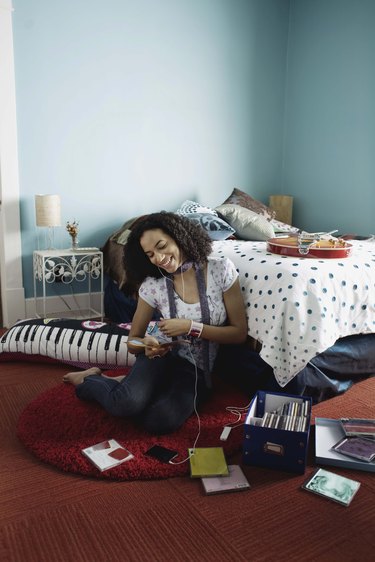Things You'll Need
Soapy water
Sponge
Degreasing product (optional)
Plastic tarp
Painter's tape
Primer
Paint brush or roller
Drywall texture mud
Mixing bucket
Window screen
Texture gun
Air compressor and hose
Cardboard
Paint

Eggshell texture, also known as orange peel texture, is a decorative technique used on interior drywall. It provides a subtle, attractive texture to walls while also disguising minor defects, such as bumps or dips, in the drywall surface. This texture is applied with a special texture gun, which can be rented from most major hardware stores. Applying eggshell texture is fairly simple once you get the hang of the technique, which can take some practice.
Step 1
Wash the wall to be textured thoroughly with soap and water. If there is stubborn grease, apply a degreasing product. Allow the wall to dry.
Video of the Day
Step 2
Place a plastic tarp on the floor and tape it to the baseboards with low-tack painter's tape. Apply additional tape to any areas that you do not want textured, such as window trim and electrical sockets.
Step 3
Apply a coat of paint primer to the walls that you plan to texture with a paint brush or roller. The primer will give the texture the best surface to adhere to. Allow it to dry completely.
Step 4
Mix a batch of drywall texture mud with water according to the instructions on the package. The mud should have the consistency of thin pancake batter to ensure that it will flow through the texture gun properly.
Step 5
Pour the mud into the texture gun's hopper through a piece of window screen to filter out any lumps.
Step 6
Connect the texture gun to an air compressor with an air hose, and set the air pressure to the PSI recommended on the mud packaging. Higher pressure while spraying results in a more-delicate texture, lower pressure results in a coarser texture.
Step 7
Test spraying on a piece of cardboard for practice before spraying the walls.
Step 8
Spray the walls in smooth, sweeping motions, holding the gun 14 to 18 inches away from the wall. Begin at the ceiling and work your way down to the floor.
Step 9
Allow the texture on the wall to dry for 15 minutes, then spray on a second layer. This layer should be perpendicular to the first. For example, if you sprayed horizontally for the first layer, this one should be vertical. This will ensure full, even coverage.
Step 10
Clean the texture gun with water after you have finished spraying. Discard any remaining texture mud.
Step 11
Allow the texture to dry for the time recommended on the mud package, then paint the walls as desired.
Video of the Day